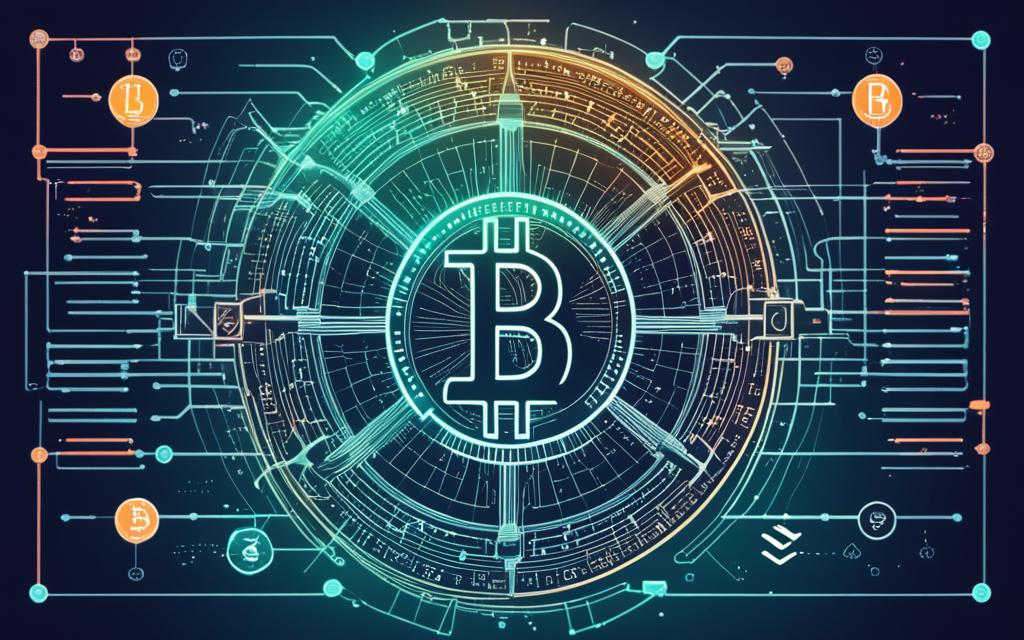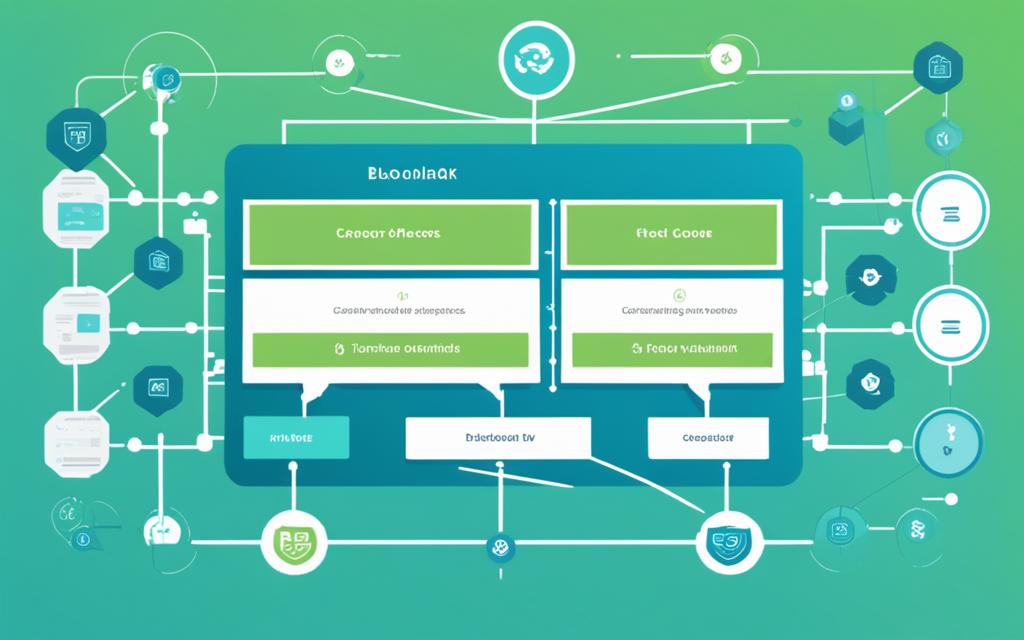Table of Contents
Blockchain technology is transforming many industries. It does this by offering a secure way to store data. In a blockchain, data is saved in blocks. These blocks are linked together. They ensure that transactions are safe and not altered1.
Each block has a unique code called a cryptographic hash. It also has the code of the block before it. This makes a continuous chain of data. This system makes sure the data can’t be changed without permission1.
Mining is the term used for adding blocks to the blockchain. Miners try to solve a complex puzzle first. It needs a lot of computer power to do this12.
When a miner adds a block, they get some cryptocurrency. This reward encourages miners to keep adding blocks. That’s how the chain grows12.
Usually, a new block is added every few minutes. But the time can vary depending on the blockchain. This regular addition makes sure the transaction record stays current12.
Blocks are key to keeping the network safe. They record transactions permanently. This makes a clear and secure list of transactions1.
Key Takeaways:
- Blockchain technology enables secure and tamper-proof data storage by organizing data into blocks1.
- Each block has a unique cryptographic hash and includes the hash of the previous block, forming an unbroken chain1.
- Mining is the process of adding blocks to the blockchain by solving a complex proof-of-work algorithm12.
- Miners are rewarded with cryptocurrency for successfully adding blocks to the blockchain12.
- New blocks are added to the blockchain regularly to maintain an updated ledger system12.
- Blocks ensure the integrity and security of the blockchain by recording transactions permanently1.
What is a Blockchain?
A blockchain is a decentralised record of transactions, known as distributed ledger technology. It is used in many fields like real estate and healthcare3. It removes the need for a central authority. This ensures transactions can’t be changed after they’re recorded. This makes transactions safer, more trusted, and faster.
Proof-of-work is a method used by blockchain to check transactions and make new blocks. Bitcoin miners check transactions to add new bitcoins. This process takes about 10 minutes. Many efforts are made to make blockchains more efficient and cheaper3. Not just for Bitcoin but for thousands of other cryptocurrencies too.
Ethereum’s blockchain allows creating unique digital items, smart contracts, and new finance apps4. This marks the beginning of ‘Web 3’, where the internet gets a major upgrade. Thanks to blockchain, people can have more control over their money and information4. Companies also find many uses for it, like in tracking products or making international payments cheaper4. It’s even used for fighting fraud and protecting ideas.
In 2008, Satoshi Nakamoto invented blockchain for Bitcoin’s transactions5. But its uses have grown to many other areas. It helps in making payments, watching product supply chains, keeping digital records, and more5. It’s especially great because it’s fast, doesn’t need many checks, and is very secure against fraud or hacking5.
Blockchain technology is changing how business is done by offering a safe, open, and quick way to record transactions. It affects everything from banking to tracking goods, and it promises a bright future for many sectors.
How Does a Blockchain Work?
A blockchain is like a digital, public ledger. It keeps data secure and in order without a central authority. Multiple computers work together to check and add new information.
The blocks in a blockchain are containers for data. They hold info about events or transactions. Every block links to the one before it, making a chronological chain.
Inside each block, there’s a section for the real data. This might include details of transactions or even smart contracts. This open data approach helps keep everything honest and clear.
A hash is a unique code for each block. It works like a digital stamp to ensure the block is unchanged. Thus, protecting the whole chain from being tampered with.
Many computers, or nodes, keep a copy of the blockchain. This shared record is called a distributed ledger. It stops any one person or group taking control. So, everyone can trust it more.
Mining is how new blocks are made. Miners use special computers to solve tough puzzles. This process checks transactions and adds them to the blockchain. Miners are rewarded for their work, encouraging them to help keep the system secure.
Blockchains are open for anyone to be part of it. This openness encourages new ideas and teamwork. It makes processes more transparent, pushing everyone to work better together.
These digital ledgers offer many benefits, like making information more secure. They also help avoid mistakes and speed up work. By using smart digital rules, they make sure things are fair and correct.
| Blockchain Benefits | Challenges |
|---|---|
Blockchain goes beyond money to help many fields. It makes banking, healthcare, and even the way we buy and sell art more secure. All by using its smart digital system.
In summary, a blockchain is a clever way to connect information safely. It uses shared records, digital checks, and agreement rules to bring trust and new ideas to many areas76).
Consensus Mechanisms in Blockchain
In the blockchain and crypto world, consensus mechanisms are key for network integrity and security. The main ones are proof-of-work (PoW) and proof-of-stake (PoS)8. They decide how transactions get checked and how new blocks join the chain.
Proof-of-work is used by networks such as Bitcoin and Litecoin8. Miners race to solve tough maths problems. This activity supports transaction checks and block creation. Yet, it uses up a lot of energy and computing power.
But proof-of-stake is a greener option than PoW8. Here, validators check transactions. They’re chosen depending on how many coins they own in the network. This way, the more you have, the bigger your chance to validate. This system aims to ensure that validators act honestly.
Besides PoW and PoS, there are other methods, like proof-of-capacity (PoC), proof-of-activity (PoA), and proof-of-burn (PoB)8. Scientists keep looking for better ways to manage blockchain. They often use AI and machine learning. These tools help improve security, size, and how decentralized a network is.
Keeping the blockchain secure and reliable is the goal of consensus mechanisms. They give multiple network nodes the job of checking trades. This keeps the blockchain decentralized and uses automated checks to stop attacks8.
There are many types of consensus mechanisms, each placing importance on different goals, like growing, security, or staying decentralized. The way forward is to make systems that are fairer, eco-friendly, and faster without lessening security and decentralization8.
Adding Blocks to the Blockchain: Bitcoin Example
Bitcoin was the first to use blockchain tech. It uses proof-of-work to add blocks. This includes checking transactions, mempools, and miners.
When someone sends or receives Bitcoin, this info is recorded. Then, it’s put into a block.
Statistical data from link 1: Each Bitcoin block can hold just one megabyte. Roughly, six new blocks are added every hour. It takes about ten minutes to add each block9. Each block has a header, which is 80 bytes long. It has details like Version and Time9.
Once in a block, it goes to the mempool. Miners check these blocks. They make sure the transactions are real and correct. Doing this needs a lot of computing power.
The Mempool and Miners
Statistical data from link 2: Transactions sit in the mempool before getting into a block10. This means a lot of transactions are waiting at once10. Miners keep trying different numbers until they find one that works. It’s like a game of guess and check10 to make the block fit.
When a block is right, it’s shared with everyone. The network checks it. If it’s good, the block is added to the blockchain. This way, only true transactions become part of the chain.
Miners earn Bitcoin for doing this work. This reward keeps them mining. It also keeps the blockchain safe and honest9.

The Role of Blocks in the Blockchain
Blocks are key in the blockchain, keeping it secure and true. They hold transactions, the last block’s reference, and a unique nonce. This makes an unchangeable record chain.
Adding blocks means adding true and unchangeable records. This makes the whole network safe and trusted. It’s perfect for industries needing secure data storage.
Adding a block uses cryptography, agreement, and lots of computer power. Miners race to solve puzzles and confirm transactions. This adds new blocks securely.
Reference: Investopedia11
Blocks are linked by unique hashes. Each block has the last one’s hash, making them secure. Changing a block’s data would need to alter every following block.
“The hash of the previous block acts as a seal, ensuring the integrity and security of the entire chain. Any modification to the data within a block would result in a change in its hash, making it invalid and disrupting the entire chain.”
Each block’s timestamp is like a data time stamp. It proves when data was there, stopping changes. This, with hashes, secures the data.
There’s also a nonce in each block, used only once. This, with other block parts, makes a unique hash. It helps keep the data safe from changes.
Blocks take time to create. Ethereum’s blocks are created quicker, in 14-15 seconds, than Bitcoin’s, which takes about 10 minutes.
Reference: TechSkill Brew12
Blocks are used beyond just money transfers. They’re vital in many fields like banking and healthcare. They safely hold votes, inventories, health records, and NFT ownership.
Blocks are crucial in the blockchain. They protect and make the network reliable. With each added block, the blockchain gets stronger against tampering. It’s a great option for managing data challenges in many sectors.
How Blocks are Created in the Blockchain
Blocks in the blockchain get made by mining. Mining means solving a hard maths problem. This problem is the proof-of-work algorithm, a kind of cryptographic puzzle. Miners solve it to check transactions and add blocks to the chain.
To mine, you need a lot of computer power. Miners race to solve the puzzle first and earn rewards. These rewards keep the blockchain safe and right.
A miner creates a new block when they solve the puzzle. This block links to the last one, keeping the chain in order. It also has a special nonce and the checked transactions become final.
After creation, the new block must pass a check. The network makes sure it’s correct. This check follows rules like checking the block’s hash and adding necessary details, according to Bitcoin13.
If the block checks out, it’s added to the blockchain. Every block on top makes the chain stronger and safe from changes13.
Overview of Block Creation in the Blockchain
| Process | Details |
|---|---|
| Mining | Solving the proof-of-work algorithm to validate transactions and add new blocks to the chain1413. |
| Block Structure | Comprising a hash of the previous block, a unique nonce, and validated transactions14. |
| Validation | Verification of the block’s integrity, including correctness of its hash, required information, and adherence to system conditions13. |
| Blockchain Formation | Addition of the new block to the blockchain, creating a sequential chain of transaction history13. |
Creating blocks is vital for the blockchain. It makes sure everything is right, safe, and clear. Mining with the proof-of-work algorithm keeps cryptocurrencies dependable and honest1413.
Rejolut and others have helped a lot with blockchain tech. They’ve worked on big projects and won contests. Their work with things like smart contracts has made them experts in the blockchain world15.
The Structure of a Block
A block in a blockchain has a block header, a transaction counter, and list of transactions. These parts ensure the blockchain is secure and reliable.
The block header is key in every block. It holds the blockchain’s version, the last block’s hash, merkle root, timestamp, difficulty target, and nonce16. The version tells which technology version is in use. The last block’s hash links the block with the chain16. The merkle root is a hash from a Merkle tree’s root, saving the block’s transactions16. The timestamp shows the block’s creation time16. The difficulty target decides the work algorithm’s hardness16, while miners use the nonce to find the correct one in a series of tries16.
The transaction counter shows how many transactions the block has. These are deals and asset movements that are the blockchain’s core. They’re coded and keep data safe and unchanged17. The counter tells you quickly how many transactions are inside.
The list of transactions is the main content of a block. It can have different data like money moves or smart contracts. Each piece is hidden and connected to the ones before, making a data chain17.
To better see how a block is built, check the table below:
| Component | Size (bytes) |
|---|---|
| Block Header | 80 |
| Version | 4 |
| Previous Block Hash | 32 |
| Merkle Root | 32 |
| Timestamp | 4 |
| Difficulty Target | 4 |
| Nonce | 4 |
| Transaction Counter | Varies |
| Transactions | Varies |
The block header and transaction counter have a set size. The list of transactions might change, depending on how many are inside the block18.
Seeing a block’s structure visually shows how all its parts work together. This harmony is what keeps the blockchain moving smoothly.
Blocks in Blockchain Uses Beyond Cryptocurrency
Blockchain goes further than being tied to cryptocurrencies like Bitcoin. It offers many chances for numerous fields through its ability to support smart contracts and NFTs. This tech promises to shake up various sectors by boosting their efficiency, transparency, and security.
In finance, blockchain simplifies payments, cuts down fraud, and makes things clearer. For instance, Visa began using blockchain for global business payments in 2017. This move showed its potential to be widely used in the finance world19. With blockchain pros in high demand, the US average salary in March 2023 was $90,94219. This highlights the need for experts in this growing field. Blockchain project managers also hold vital roles, earning about $79,974 annually in the US19.
It also shines in supply chain management by boosting the openness and trackability of products. Walmart uses blockchain for its food supply chain, allowing quick spotting of pollution20. This use could transform food safety and bolster customer protection.
In healthcare, blockchain secures patient files and makes sharing data between providers safer. Big names like Humana and UPS have started using this tech to make their work more efficient and trustworthy20. It also aids in managing drug supply chains and enhancing clinical trials, bringing more openness and honesty into healthcare20.
Beyond finance and healthcare, blockchain has a wide scope. It benefits the music, entertainment, and media world by easing direct sales, ensuring artists get paid fairly, and fending off fraud and piracy20. Real estate and hospitality industries can use it to work smoother, cut down on mistakes, make bookings faster, and offer shared ownership of properties20. The IT sector finds it helpful for making software sharing safe, managing digital rights, and even in games for keeping track of precious digital items and trading them20.
Blockchain is making its way into every corner of businesses, suggesting it could revolutionise many fields. As the tech keeps developing, experts believe almost every industry will adopt blockchain to conduct digital business more efficiently, safely, and openly20.
| Type of Industry | Applications of Blockchain Technology |
|---|---|
| Finance | Payment processes, fraud reduction, financial transparency19 |
| Supply Chain Management | Transparency, traceability, swift identification of contamination sources2120 |
| Healthcare | Securing patient records, seamless data sharing, improving clinical trials and pharmaceutical supply chains2120 |
| Music, Entertainment, and Media | Direct distribution, royalty payments, fraud protection, copyright enforcement20 |
| Real Estate and Hospitality | Streamlining operations, reducing errors, speeding up reservations, fractional ownership20 |
| IT Industry | Software distribution security, digital rights management, gaming asset ownership and transferability20 |
The Importance of Blocks in Blockchain Security
Blocks are vital for keeping the blockchain system safe. Each block has secret data tied safely to the last, making a chain that we can trust. Encryption, and the strong ideas of keeping the data unchanged, boost the blockchain’s safety.
Block encryption stops unauthorised touching or looking at important data. It turns the block’s details into a tough code. Only someone with the right key can make sense of this. This keeps the data safe from bad people.
Data integrity is key in blockchain safety. Each block has a special mark that comes from its data. Even the smallest change gives a new mark. So, we can know if anyone tries to change what’s stored, keeping things true.
Once written in a block, the blockchain rarely changes. This is because fixing one block means fixing them all. It would take a huge effort. So, the blockchain’s history stays solid and trustworthy against cheat and lies.
Looking at evidence22 shows there are dangers to the blockchain. For example, the DAO lost a lot because of a code mistake. Bithumb was hacked, losing bitcoin and user details. And there are threats like 51% attacks.
Yet, block encryption and rigidity mean the blockchain is largely safe. They, along with ways to agree and other safety steps, help protect the network. They make us trust the technology even more.
Ensuring Block Security with Encryption, Data Integrity, and Immutability
For safe blocks, three things are vital:
- Strong Encryption: Use the best code methods to keep block data secret.
- Data Integrity Checks: Make sure block data is solid and unchanged with special checks.
- Immutability: Set rules and work together to keep the blockchain’s past unchanged without wide agreement.
Sticking to these rules and having strong security makes the blockchain world safer. This way, we can trust the tech more to keep data and transactions secure.
Blockchain Security Measures
| Security Measure | Description |
|---|---|
| Encryption | Turns block data into an unreadable form to hold it safe from wrong hands. |
| Data Integrity | Double-checks block data to guarantee it’s real, using special marks. |
| Immutability | Stops anyone from changing the blockchain by making it really hard to do without all agreeing. |
| Consensus Mechanisms | Creates rules to agree on trades and keep the blockchain secure from fraud. |
| Advanced Network Monitoring | Uses strong tools to watch for and stop unwanted access, keeping the blockchain safe. |
So, blocks are crucial for the blockchain’s safety. With steps like encryption and block strength, the blockchain can protect its info and deals. But, we must stay alert to new dangers and always look for better ways to stay safe in the blockchain world.
Future Developments in Blockchain
There’s a lot happening in the world of blockchain. We’re seeing new and exciting changes that make our digital future safer and more open to everyone. This technology will not only change how we do many things but also how interact and own online stuff.
One big change coming our way is Web 3.0. It’s the next step for the internet, making everything online more open and putting you in control of your own data and online things.
In the Web 3.0 world, you can own online stuff and make money from it. This is all thanks to blockchain. Artists, writers, and other creators can get what they deserve for their work, without big companies taking a cut.
Also, Web 3.0 makes sure your data is safe. With special ways of keeping data private and secure, you can be sure no one is looking at your stuff without permission. This makes the online world a place you can trust more.
Blockchain isn’t just for your online life. It’s changing how money works too. Now, with DeFi apps, people everywhere can get bank services, loans, and make investments easily, no matter where they are or how much money they have.
And it’s not stopping there. Companies are looking into using blockchain for things like tracking products, keeping health records safe, protecting ideas, and even making voting safer and fairer. Its way of being clear, trackable, and safe makes it perfect for these important jobs.
But, as blockchain grows, there are things we need to work on. For instance, making it able to handle more people and more things at once. People are working on this, thinking of new ways to make blockchain work better for everyone.
Making different blockchain networks work well together is also something important for the future. This way, everything can run smoothly and get the most out of the technology.
As the world of blockchain changes, everyone involved needs to keep learning. People working on it, using it, and making sure it’s fair and safe for everyone – they all should keep talking and sharing. This is how we make sure blockchain does all the great things it can do.
| Blockchain Advancements | Web 3.0 | Ownership of Digital Content |
|---|---|---|
|
– Consensus mechanisms for blockchain can include Proof of Work, Proof of Stake, Byzantine fault-tolerant, Deposit-based consensus, and Proof of Elapsed Time23. – When choosing a blockchain platform, factors to consider include problems to be solved, consensus mechanisms, cost, developer requirements, and expected timeline23. – Considerations for designing blockchain nodes include determining if a permissioned or permissionless network is needed, selecting programming languages, and choosing between private, public, or hybrid solutions23. – Configuration elements for blockchain platforms can involve permissions, asset issuance, key management, multi-signatures, address formats, key formats, block signatures, and more23. |
– Blockchain principles include decentralization, transparency, consensus mechanisms, cryptography, and tokenization, all of which contribute to the security and integrity of the blockchain network24. – Companies utilize blockchain technology for various applications, including blockchain wallets, smart contracts, decentralized apps, asset tokenization platforms, DAOs, blockchain consulting, interoperability solutions, ZKP chains, and web app development with blockchain integration24. – Benefits of blockchain technology for businesses include enhanced security, increased transparency, traceability of transactions, reduced transaction costs, and resilience against centralized control and system failures24. – Blockchain is utilized across various industries, including financial institutions, governments, healthcare, eCommerce, real estate, legal, cryptocurrency, and technology companies24. |
– Blockchain operates on a decentralized network of computers where each node stores a copy of the entire blockchain, enhancing security and eliminating the need for a central authority25. – Transactions are grouped into blocks, which are cryptographically linked to form a chain, creating a tamper-evident record of transactions25. – Consensus mechanisms like Proof of Work (PoW) and Proof of Stake (PoS) are used to validate and add new blocks to the blockchain25. – Altering a transaction on the blockchain is computationally infeasible due to the distributed nature of the network, making transactions virtually immutable25. |
Conclusion
In the end, blocks are vital in the blockchain. They make sure transactions are safe and clear in a big network without a centre. Adding a block needs miners to solve hard puzzles. They get rewards for this, like a block usually being about 1MB big and holding about 2000 transactions26.
The blockchain works by spreading its power across many computers. This setup makes it hard for someone to cheat. Two common ways it checks blocks are Proof of Work and Proof of Stake27.
The safety of blockchain comes from special codes called hash functions. They keep information safe and in the same length27.
Blockchain is hard to change, making it perfect for keeping records27.
As time goes on, blockchain is finding new ways to help in finance, insurance, health, and managing supplies27.
FAQ
What is blockchain?
Blockchain is a technology that stores transactions in a chain. It runs across different fields, not only crypto. This digital record keeps all transactions secure and unchangeable.
How does a blockchain work?
It’s a system where transactions gather in blocks and link together. This creates a secure, fast, and trustworthy environment. It also does this without a central figure, using smart contracts instead.
What are the consensus mechanisms in blockchain?
To confirm transactions, blockchain uses particular ways, like proof-of-work and proof-of-stake. The first way needs solving puzzles, whereas in the second, those with the most network share can decide.
How are blocks added to the blockchain in the Bitcoin example?
A user kicks off a Bitcoin transaction, and it gets put in a block. This block then goes to the mempool for checking by miners. After it’s confirmed, it becomes part of the chain, proven by network nodes.
What is the role of blocks in the blockchain?
Blocks make sure all transactions are safe and trusted by chaining them together. Once a block enters the chain, that transaction is secure and open for everyone to see.
How are blocks created in the blockchain?
Creating blocks is mining’s job. This includes cracking complex puzzles. The first miner to solve a puzzle earns the right to add a block to the chain.
What is the structure of a block?
A block has a header, a counter for transactions, and the actual list of these interactions. The header notes important details like the last block’s code and the time it was made. The transaction list makes most of the block.
What are the uses of blockchain beyond cryptocurrency?
Blockchain has many other uses in fields like finance, tracking goods, and health care. It makes smart contracts and non-fungible tokens possible, bringing new, safer ways to do deals.
Why are blocks important for blockchain security?
Blocks are the backbone of the chain, securing all the data. Each block connects to the one before, which stops any interference. This makes the whole system highly secure and trustworthy.
What are the future developments in blockchain?
The future of blockchain will focus on being greener, more useful in different areas, and part of the new internet. It will give users more power over their data and spawn new money and business ways.
Source Links
- https://www.linkedin.com/pulse/how-blocks-created-blockchain-sindhu-harisakthi – How Blocks are Created in Blockchain?
- https://learnmeabitcoin.com/technical/mining/ – Adding New Blocks to the Blockchain
- https://www.coindesk.com/learn/how-blocks-are-added-to-a-blockchain-explained-simply/ – How Blocks Are Added to a Blockchain, Explained Simply
- https://www.investopedia.com/terms/b/block-bitcoin-block.asp – What Is a Block in the Crypto Blockchain, and How Does It Work?
- https://www.synopsys.com/glossary/what-is-blockchain.html – What Is Blockchain and How Does It Work? | Synopsys
- https://builtin.com/blockchain – Blockchain: What It Is, How It Works, Why It Matters
- https://www.simplilearn.com/tutorials/blockchain-tutorial/blockchain-technology – What is Blockchain Technology? How Does Blockchain Work? [Updated]
- https://www.investopedia.com/terms/c/consensus-mechanism-cryptocurrency.asp – What Are Consensus Mechanisms in Blockchain and Cryptocurrency?
- https://www.gemini.com/cryptopedia/what-is-block-in-blockchain-bitcoin-block-size – What Is a Block in the Blockchain? Block Structure | Gemini
- https://learnmeabitcoin.com/beginners/guide/blocks/ – What is a Block in Bitcoin?
- https://www.investopedia.com/terms/b/blockchain.asp – Blockchain Facts: What Is It, How It Works, and How It Can Be Used
- https://medium.com/techskill-brew/what-is-a-block-in-the-blockchain-part-2-blockchain-basics-53ad20c766cc – What is a Block in the Blockchain? (Part 2- Blockchain Series)
- https://academy.bit2me.com/en/bitcoin-mining-how-to-create-a-block/ – Bitcoin mining How do you create a block?
- https://www.bitstamp.net/learn/crypto-101/what-are-blocks-in-the-blockchain/ – What are the blocks in blockchain? – Bitstamp Learn Center
- https://rejolut.com/blog/creating-your-own-blockchain-network/ – Create Your Own Blockchain from Scratch in 8 Simple Steps
- https://www.geeksforgeeks.org/blockchain-and-block-header/ – Blockchain and Block Header – GeeksforGeeks
- https://www.geeksforgeeks.org/blockchain-structure/ – Blockchain Structure – GeeksforGeeks
- https://dev.to/siddharthsing/block-anatomy-of-a-blockchain-4773 – Blockchain Block Anatomy
- https://www.coursera.org/articles/blockchain-cryptocurrency – Blockchain in Cryptocurrency: Beginner Guide and Career Outlook
- https://www.tdk.com/en/tech-mag/past-present-future-tech/impact-of-blockchain-technology-on-business – Blockchain Reimagined: Impacting Industries Beyond Cryptocurrency
- https://www.linkedin.com/pulse/explanation-blockchain-basics-thomas-r-alber-uohjc – An Explanation of Blockchain Basics
- https://www.ibm.com/topics/blockchain-security – What Is Blockchain Security? | IBM
- https://www.xilinx.com/products/design-tools/resources/the-developers-guide-to-blockchain-development.html – The Developer’s Guide to Blockchain Development
- https://binariks.com/blog/guide-to-blockchain-development-process/ – The Ultimate Guide to Blockchain Development Process
- https://www.linkedin.com/pulse/unlocking-future-5-blockchain-projects-wqsac – 🔗🤖 Unlocking the Future: 5 Blockchain Projects Using AI to Shape Tomorrow 🚀🌐
- https://www.shiksha.com/online-courses/articles/structure-of-a-block-in-blockchain/ – Structure of a Block in Blockchain – Shiksha Online
- https://intive.com/insights/blockchain-basics-key-things-to-know – Blockchain Basics: Key Things to Know








